Wholesale to Trade Only
Your Online Source for Wholesale Diamonds


The standard unit of weight used for gemstones. One carat equals .200 grams (or 200 milligrams). Usually abbreviated ct.
Diamonds are weighed to a thousandth (0.001) of a carat and then rounded to the nearest hundredth, or point. Over a carat, diamond weights are usually expressed in carats and decimals. A 1.03 ct. stone in your diamond jewelry, for example, would be described as "one point oh three carats," or "one oh three." A diamond that weighs 0.83 ct. is said to weigh "eighty-three points," or an "eighty-three pointer."
Refers to the degree to which a diamond is colorless. Diamond color has a significant impact on its value. The color scale ranges from D to Z, from colorless to light yellow. Warmer colored diamonds (K-Z) are particularly desirable when set in yellow gold. Icy winter whites (D-G) look stunning set in white gold or platinum.
Color Grade Diagram

|
Color Grade |
Description |
|
D |
This is the highest Color Grade and absolutely colorless. Price is high due to its rarity but hey, if you can afford it, go ahead... |
|
E |
It is colorless to the unaided eye. Only a trained gemologist using special equipment can determine any color difference between a D- and an E-color diamond. This is considered a rare diamond. |
|
F |
Colorless, a slight color detected by an expert gemologist, but still considered a Colorless grade and a high-quality diamond. This will work with any white gold or platinum. |
|
G |
This diamond is nearly colorless with an extremely faint tint that is noticeable only to a trained gemologist. G-color diamonds are ideal for beautiful jewelry because they offer an outstanding value at a lesser price compared to the colorless grades, but it still appears to be colorless when mounted. |
|
H |
This has an advantage of exceptional value due to the near colorless range. This diamond will appear colorless when mounted on a very slight tint of color. |
|
I |
Near-colorless with a slightly detectable tint and is an excellent value. |
|
J |
J, J, J... what can i say. Might look better when viewed in the day. Or even better if you may... less to pay to go for a K. |
|
K |
This grade begins to show a tint of color when they are of half carat or more. If mounted in white color metals, they may appear as a J-grade. |
|
L |
Diamonds graded L show visibly more marked color, and are classified as faintly tinted or colored. |
|
M |
Slightly tinted, the line between an L- and M-grade diamond is so thin. |
|
N - Z |
Color noticeable by the naked eye. |
Fancy Color Grade Diagram

|
Color Grade |
Description |
|
FLY |
Fancy light yellow. |
|
FY |
Fancy Yellow. This color range has yellow hue but less saturated. These stones are very beautiful but less expensive than intense and vivid range. |
|
FI |
Fancy Intense. Intensity color range for diamonds have richer color and quality. Values of this kind of diamond are higher. |
|
FYV |
Fancy Yellow Vivid. Vivid yellow diamonds are the rarest and most unique diamonds. These characteristics make it the most expensive kind from any other range. |
Grading Natural Fancy Yellow Color Diamond
Diagram of Fancy Yellow Colored Diamonds (Canary)
Range from Vivid to Light
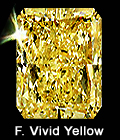
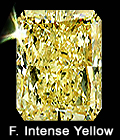
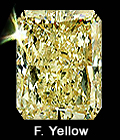
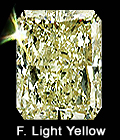
Diagram of Non-fancy Diamond
Range from Z - U
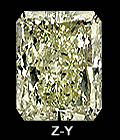
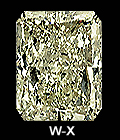
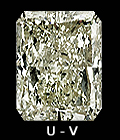
Most diamonds used as gemstones are basically transparent with little tint, or white diamonds. The most common impurity, nitrogen, replaces a small proportion of carbon atoms in a diamond's structure and causes a yellowish to brownish tint.
Beautiful yellow diamonds exist in tones from light yellow to fancy intense vivid yellow, also named Canary Yellow, depending on the concentration of nitrogen when the crystal is formed. Yellow diamonds are more desirable than white diamonds, due to their warm color. In fancy diamonds, inclusions are mostly not noticeable to the naked eye because of its rich color, inclusions does not affect the look or its sparkles not like in clear diamonds.
Natural fancy coloured diamonds are very rare and expensive. Most people believe that yellow diamonds are less desirable and valuable than white diamonds. While this is true of faintly coloured or off-white diamonds, intensely coloured diamonds are very attractive, rare and expensive. The Kimberley Octahedron is the largest diamond in the world at about 616 carats, and is yellow.
Grading fancy color diamonds
Yellow or brown color diamonds having color more intense than "Z", as well as diamonds exhibiting color other than yellow or brown are considered fancy colored diamonds. These diamonds are graded using separate systems which indicate the characteristics of the color, and not just its presence. These color grading systems are similar to those used for other colored gemstones, such as ruby, sapphire, or emerald, than they are to the system used for white diamonds.
GIA colored diamond grading system
The GIA issues grading a Colored Diamond Grading Report for colors that are not in the normal color range of diamonds. Formal GIA terms used to describe natural yellow diamonds:
Fancy Vivid Yellow- Vivid yellow diamonds are the rarest and most unique diamonds. These characteristics make it the most expensive kind from any other range. This range has the richest and most intense hue of all.
Fancy Intense Yellow- Intensity color range for diamonds have richer color and quality. Values of this kind of diamond are higher.
Fancy Yellow- This color range has yellow hue but less saturated. These stones are very beautiful but less expensive than intense and vivid range.
Light Fancy Yellow- There is slight yellow tint that can be detected by human eye on this color range. The buyer perception of color for yellow diamonds is confident, intelligent and wordly. Lighter shades are a great value because they still look yellow, yet you can have more size for the money.
Gran Colorimeter
Color can also be determined using a device called the Gran Colorimeter, manufactured by Sarin Technologies. It measures from D to Z to Fancy Intense with an accuracy within ±½ of a color grade on loose stones from 0.25 to 10 carats (as low as .15 carat or as high as 20 carats with reduced accuracy), and you can specify which grading scale it should use (GIA, GEM, IGI, AGS, HRD, and others). The accuracy is within ±1 color grade for mounted stones. If you diamond is a "G" color it will tell you whether it's a "high G" or a "low G". The Gran colorimeter was first developed by Paul Gran in 1972 at Gran Computer Industries Ltd.
|
Independent Gemological Laboratories
A diamond grading certificate is a report given by an independent and professional gemological laboratory. The diamond is evaluated for its quality, not its value. Every diamond is unique. The certificate will map out all the diamond's recognizable and individual characteristics. Each certificate will include the diamond's color, clarity, carat weight and cut information (see the 4 C's). The grading report also includes a hand-drawn map of the diamond's inclusions. Since no two diamonds are exactly alike you can always check that the certificate matches the diamond. When it comes to certification and appraisal, you need absolute accuracy, precision and reliability. That is why our stones are appraised by two of the most respected laboratories in the Trade. | |
 | |
| GEMOLOGICAL INSTITUTE OF AMERICA (GIA) | |
|
An independent nonprofit organization, the Gemological Institute of America (GIA) is renowned for its impartial service as the world's foremost authority in gemology. The Institute's history of ground-breaking scientific research, education, and gemological laboratory services reads as a virtual chronicle of the industry's own growth and sophistication.
From 1953, when Richard T. Liddicoat created and introduced the International Diamond Grading System™ - to the position the Institute holds today as the most respected grading and identification authority in the world - GIA has combined the principles of research, education, and service to help gem and jewelry professionals around the globe use science and product knowledge to sustain the public's trust. The GIA can be reached at: World Headquarters The Robert Mouawad Campus 5345 Armada Drive Carlsbad, California 92008 Telephone: (800) 421-7250 or (760) 603-4000 E-mail: ghill@gia.edu | |
 | |
| EUROPEAN GEMOLOGICAL LABORATORY (EGL) USA | |
|
EGL USA is one of the largest and oldest independent gemological institutions focusing on gemstone certification and research. Originally part of an international network founded in Europe in 1974, EGL USA opened its first U.S. lab in the heart of New York's international diamond and jewelry district in 1977. In 1986 EGL USA became independently owned. Today the EGL USA Group has laboratories in New York City, Los Angeles, Vancouver, and Toronto.
EGL USA is not affiliated with any other EGL labs outside North America. Every certificate issued by our lab states "A member of the EGL USA Group." Certificate numbers are preceded by either "US" or "CA," to indicate country of origin and to provide consumers the assurance that their certificate has been issued by a member of the EGL USA Group. In 1999 EGL USA initiated a Research Department to respond to the changing needs of the jewelry industry. It is one of only a few labs worldwide doing advanced research in gemology. The EGL can be reached at: 6 West 48th Street New York, NY 10036 Telephone: 212-730-7380 Fax: 212-842-5180 E-mail: egl@eglusa.com And @ EGL USA/Los Angeles 550 South Hill Suite 840 Los Angeles, CA 90013 Telephone: 877-893-8593 Fax: 213-534-2224 |
The GIA Cut Scale ranges from Excellent to Poor and they provide a cut quality grade for standard round brilliant diamonds that fall in the D-to-Z color range. A polished diamond's beauty lies in its complex relationship with light:
The result of the complex relationship with light is a magnificent display of three attributes. Brightness is the combination of all white light reflecting from the surface and interior of a diamond. Fire describes the "flares" of color emitted from a diamond. Scintillation describes the flashes of light you see when the diamond, the light or when the observer moves.
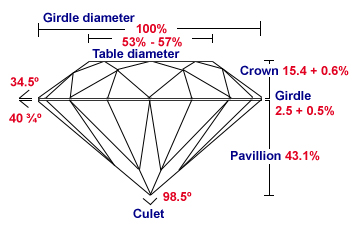
A polished diamond's proportions affect its light performance, which in turn affects its beauty and overall appeal. Diamonds with fine proportions, symmetry and polish optimize their interaction with light, and have increased brightness, fire and scintillation.
Learn about Hearts and Arrows
Bijan Diamonds Ideal Princess Cut
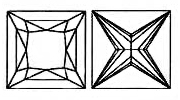
Each Bijan Diamonds Ideal Princess Cut diamond has exact proportions, and is certified to have a length-to-width ratio no greater than 1.05. The Bijan Diamonds Ideal Princess Cut diamond features a longer crown height that is almost twice the normal height that the industry is producing. The light can be absorbed more if the crown is higher, while the exquisite polish and symmetry enable the facets to display maximum brilliance. With its smaller table and precise symmetry, the Bijan Diamonds Ideal Princess Cut diamond is able to return more light. Each diamond is engineered to maximize quality over size. While typical diamonds are cut to a depth of 88% or more, Bijan Diamonds Ideal Cut diamonds are cut to a depth of 70% or less, giving up approximately 7% carat weight to ensure higher quality.
Bijan Diamonds Ideal Emerald Cut
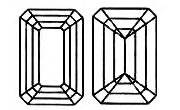
The major difference between the Bijan Diamonds Ideal Emerald Cut diamond and the standard emerald cut in the industry are the culet and higher crown. Also, Bijan Diamonds Ideal Emerald Cut diamond has outstanding proportions, symmetry, polish, maximum brilliance and ability to stop light from escaping. The brilliance is achieved by bigger crown facets which absorb more light, while the distribution of pavilion facets reflects more light. In addition, all Bijan Diamonds Ideal Emerald Cut diamonds have a guaranteed clarity of VS2 or better, so you can be assured that stones will be eye-clean.
Bijan Diamonds Ideal Asscher Cut
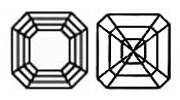
Only the finest chosen raw diamonds are cut to produce Bijan Diamonds Ideal Asscher Cut diamond to make sure of the precise proportions to get absolutely perfect length-to-width ratios. One of the major differences of Bijan Diamonds Ideal Asscher Cut diamond and the standard emerald cut in the industry is its wider corners. This perfect angle can capture more light from this eight corner as it reflect square pattern that product more brightness and sparkles. Also you will notice that the crown is about 10% higher than the standard diamond. It makes the table smaller and larger facets on the crown that capture and return more light. Another difference is having a cullet. "
Hearts and Arrows on Bijan Diamonds Ideal Round Cut
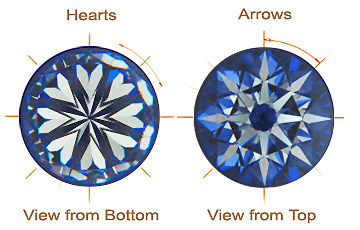
The term Hearts and Arrows is used to describe the figure that can be seen on the bottom and top of a round diamond with perfect symmetry and angles. The Hearts and Arrows effect is exist in all of Bijan Diamonds Ideal Round Cut Collection diamonds. When viewed under special magnification, the perfectly aligned facets of the Bijan Diamonds Ideal Round Cut diamond reveal the Hearts and Arrows pattern. From the bottom, eight absolute symmetrical hearts can be seen and, when viewed from the top, eight thoroughly uniform arrows can be seen. This shows how perfect and uniform each facet of a diamond which will have the maximum brilliance.
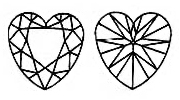

| Clarity Grade |
Description |
| FL |
Flawless. Shows no inclusions or blemishes of any sort under 10X magnification when observed by an experienced grader. No internal flaws. Very rare and very expensive. |
| IF |
Internally Flawless. Has no internal inclusions when examined by an experienced grader using 10X magnification, but will have some minor blemishes. Also very rare and very expensive. |
| VVS1 |
Very, Very Slightly Included. This contains minute inclusions that are difficult to see under 10X magnification even for experienced graders. |
| VVS2 |
Very, Very Slightly Included. Contains minute inclusions that are difficult even for experienced graders to under 10X magnification. More inclusions compared to VVS1. |
| VS1 |
Slightly Included. Contains inclusions (clouds, included crystals, knots, cavities and feathers) that are noticeable to an experienced grader under 10X magnification. Might be visible to the naked eye. Lesser inclusions as compared to VS2 and this grade is considered of good quality. |
| VS2 |
Very Slightly Included. Contains minute inclusions such as small crystals, clouds or feathers when observed with effort under 10X magnification. More inclusions as compared to VS1 but less compared to SI1. Inclusions are not visible to the unaided eye and is considered high quality. |
| SI1 |
Slightly Included. Contains inclusions (clouds, included crystals, knots, cavities and feathers) that are noticeable to an experienced grader under 10X magnification. Might be visible to the naked eye. Lesser inclusions as compared to SI2 and this grade is considered of good quality. |
| SI2 |
Slightly Included. Contains inclusions (clouds, included crystals, knots, cavities and feathers) that are noticeable to an experienced grader under 10X magnification and might be visible to the naked eye. Lesser inclusions as compared to SI3. A good diamond value. |
| SI3 |
Slightly Included. Contains inclusions (clouds, included crystals, knots, cavities and feathers) that are noticeable to an experienced grader under 10X magnification. Might be visible to the naked eye. Lesser inclusions as compared to I1. A good diamond value. |
| I1 |
Contains inclusions (possible large feathers or large included crystals) that are obvious under 10X magnification and may affect transparency and brilliance. Inclusions are visible to the naked eye. |
| I2 |
Large and/or numerous internal defects which are very easily discernible by the experienced expert with the naked eye and which diminished brilliance. |
| I3 |
Large and/or numerous internal defects which are easily discernible by the experienced expert with the naked eye and which slightly diminished brilliance. |
Top portion of the diamond, the measurement from the Girdle (center of the diamond) to the Table (top of the diamond).

| Carat Weight: |
| The weight of a diamonds is generally given in carats. Carat (ct.) is the standard unit of weight used for gemstones. 1.00 carat is equal to 0.20 grams or 200 milligrams. Diamonds are weighed to a thousandth (0.001) of a carat and then rounded to the nearest hundredth, which is called point. Over a carat, diamond weights are usually expressed in carats and decimals. A 1.05 ct. stone, for example, would be described as "one point oh five carats" or "one oh five." A diamond that weighs 0.73 ct. is said to weigh "seventy-three points," or an "seventy-three pointer." |